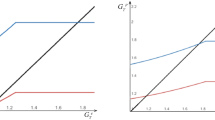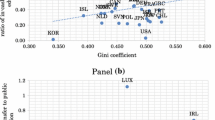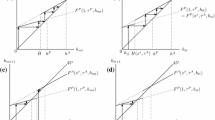Abstract
The primary objective of this paper is to highlight the distinct roles of altruism and of self-interest in the political determination of a public education policy. I assess the relative importance of three factors in the determination of the equilibrium level of this policy: altruism, the impact of public funding of education on social security benefits, and its impact on factor prices. I then focus on the impact of implementing a social security system on the equilibrium levels of education funding and on welfare. I find that although in the benchmark economy, the presence of social security might generate support for public funding of education, its overall effect on the well-being of individuals is negative for any level of social security taxation.




Similar content being viewed by others
Notes
Boldrin and Montes (2002) analyzed the joint determination of public funding of education and social security to implement an intergenerational transfer system that finances education when market incompleteness restricts private funding of education. However, they did not look at any of the policies as the result of a political process. Rangel (2003) studied the implementation of public education and social security as the result of an intergenerational game.
I drop the time subscript to simplify the notation. A prime superscript will denote a variable from next period.
A variable with a hat indicates that the variable is expressed in per capita terms.
That is, if agents believe that the political system described by the sequence ϒ will be sustained, then the political outcome for the present period will be the level τ, such that τ=ϒ(X). Their decision functions will therefore be the same as the ones obtained when agents take the whole sequence of policy decisions as given (see Section 3.1).
The politico-economic equilibrium might not be unique. To find other possible equilibria, I initialized the numerical computations at different steady states corresponding to different public education tax rates. The economy converged to the same steady-state starting values independently of the initial guess.
Note that we are not recalibrating the other parameters of the model economy as we change the value of the altruism discount factor.
Once the bequest motive is active, we have a multiplicity of equilibria. I compute the politico-economic equilibria assuming that all agents are identical within each generation. In the absence of idiosyncratic shocks, this is a stable situation, and there is only one such equilibrium in a closed economy. Although there might be more than one partial equilibrium, I never encounter such cases in the experiments.
References
Altig D, Auerbach AJ, Kotlikoff LJ, Smetters KA, Walliser J (2001) Simulating fundamental tax reform in the United States. Am Econ Rev 91(3):574–595
Belletini G, Ceroni CB (1999) Is social security really bad for growth? Rev Econ Dyn 2(4):796–819
Betts J (1996) Is there a link between school inputs and earnings? Fresh scrutiny of an old literature. In: Burtless G (ed) Does money matter? The effect of school resources on student achievement and adult success. Brookings Institution Press, Washington, DC, pp 141–291
Boldrin M, Montes A (2002) The intergenerational welfare state. Public education and pensions. Mimeo. University of Minnesota, Minneapolis
Card D, Krueger A (1996) The economic return to school quality. In: Becker WE, Baumol WJ (eds) Assessing educational practices: the contribution of economics. MIT Press, Cambridge, pp 161–181
Clotfelter C (1993) The private life of public economics. South Econ J 59(4):579–596
Cooley TF, Prescott E (1995) Economic growth and business cycles. In: Cooley TF (ed) Frontiers of business cycle research. Princeton University Press, Princeton, pp 1–38
Cooley TF, Soares J (1999) A positive theory of social security based on reputation. J Polit Econ 107(1):135–160
Fernandez R, Rogerson R (1998) Public education and income distribution: a quantitative evaluation of education finance reform. Am Econ Rev 88(4):813–833
Glomm G, Kaganovich M (2003) Distributional effects of public education in an economy with public pensions. Int Econ Rev 44(3):917–937
Juster T, Stafford F (1991) The allocation of time: empirical findings, behavioral models, and problems of measurement. J Econ Lit 29(2):471–522
Kaganovich M, Zilcha I (1999) Education, social security, and growth. J Public Econ 71(2):289–309
Kemnitz A (2000) Social security, public education, and growth in a representative democracy. J Popul Econ 13(3):443–462
Konrad KA (1995) Social security and strategic inter-vivos transfers of social capital. J Popul Econ 8(3):315–326
Krusell P, Quadrini V, Rios-Rull V (1997) Politico-economic equilibrium and economic growth. J Econ Dyn Control 21(1):243–272
Miron JA, Weil DN (1997) The genesis and evolution of social security. In: Michael B, Goldin C, White E (eds) The defining moment: the Great Depression and the American economy in the twentieth century. University of Chicago Press, Chicago, pp 297–322
Pogue TF, Sgontz LG (1977) Social security and investment in human capital. Natl Tax J 30(2):157–169
Rangel A (2003) Forward and backward intergenerational goods: why is social security good for the environment? Am Econ Rev 93(3):813–834
Soares J (2003) Self-interest and public funding of education. J Public Econ 87(3):703–727
Soares J (2004) Public education reform: community or national funding of education? J Monet Econ 52(3):669–697
Acknowledgements
I gratefully acknowledge support from the Human Capital Mobility, E.C., fellowship and the Innocenzo Gasparini Institute of Economic Research. I am also grateful to Thomas Cooley, Jeffrey Campbell, Sergio Rebelo, Per Krusell, Victor Rios-Rull, Guido Tabellini, Arun Malik, and two anonymous referees for helpful comments.
Author information
Authors and Affiliations
Corresponding author
Technical Appendix
Technical Appendix
In this appendix, I describe the procedure used to compute the political-economic equilibria for the model economy.
I apply an approach similar to the one used in Krusell et al. (1997) to solve for the politico-economic equilibrium of the economy. I solve for the recursive equilibria for a given political outcome function, and then I solve the political problem. An equilibrium is attained when the political choice corresponds to the one resulting from the given political outcome function; otherwise, the political outcome function is updated, and the procedure continues.
The procedure can be described as follows (see Krusell et al. 1997 for a more detailed description):
-
1.
Make a guess on the tax rate on income τ 0 and compute the corresponding steady state (A 0, S 0).
-
2.
Approximate the utility functions of the different-generation agents around this steady state with a quadratic function and solve for the value functions of these agents. Start from the old agents' problem and work backward to the first-generation agents'. As I solve the agents' problems, I get decision rules as functions of individual and aggregate state variables as well as the tax rate.
-
3.
Substituting these decision rules in the agent's problem, I get the value function in function of individual and aggregate state variables as well as the tax rate.
-
4.
Maximizing the value function corresponding to the pivotal voter with respect to the political parameter, I obtain a political decision in function of aggregate state variables and individual state variables of the pivotal voter. I can then aggregate this function and obtain a political outcome function that is only a function of aggregate state variables. I iterate on this approximation until I converge to a function ϒ 0(A 0, S 0|τ 0).
-
5.
Compare the tax rate implied by this political outcome function τ=ϒ 0(A 0, S 0|τ 0) with the initial guess, τ 0. If the tax rates are different, I update the initial guess and go back to step 1. Otherwise, a political and economic equilibrium has been found.
Rights and permissions
About this article
Cite this article
Soares, J. A dynamic general equilibrium analysis of the political economy of public education. J Popul Econ 19, 367–389 (2006). https://doi.org/10.1007/s00148-005-0034-y
Received:
Accepted:
Published:
Issue Date:
DOI: https://doi.org/10.1007/s00148-005-0034-y




